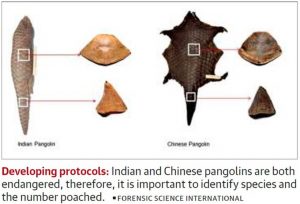Indian Researchers Have Sequenced 624 Pangolin Scales:

Indian Researchers have sequenced 624 pangolin scales, thereby categorizing the Indian and Chinese pangolins.
- Pangolins, despite being listed in Schedule I of Wildlife (Protection) Act, 1972 continues to be the world’s most trafficked mammal.
- The primary demand for its scales in the making of traditional East Asian medicines has led to an estimated illegal trade worth $2.5 billion every year.
- To enforce the appropriate national and international laws and to track the decline of the species, researchers of the Zoological Survey of India (ZSI), Kolkata, have now developed tools to tell apart the scales of Indian pangolin (Manis crassicaudata) and Chinese pangolin (Manis pentadactyla).
- They characterized the morphological features and investigated genetic variations between the two species by sequencing 624 scales of pangolins and comparing the sequences with all eight pangolin species.
- Based on the size, shape, weight, and ridge counts on the scales, the team was able to categorize the two species of Indian and Chinese pangolins.
- Though the Chinese pangolin is distributed mostly in Vietnam, Thailand, Cambodia, the north-eastern part of our country is also its home.




